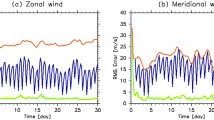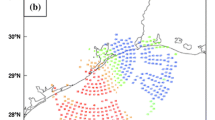Abstract
A Variational Echo Tracking (VET) technique has been applied to four months of archived data from the South Korean radar network in order to examine the influence of the various user-selectable parameters on the skill of the resulting 20-min to 4-h nowcasts. The latter are computed over a (512 × 512) array at 2-km resolution. After correcting the original algorithm to take into account the motion of precipitation across the boundaries of such a smaller radar network, we concluded that the set of default input parameters initially assumed is very close to the optimum combination. Decreasing to (5 sx 5) or increasing to (50 × 50) the default vector density of (25 × 25), using two or three maps for velocity determination, varying the relative weights for the constraints of conservation of reflectivity and of the smoothing of the velocity vectors, and finally the application of temporal smoothing all had only marginal effects on the skill of the forecasts. The relatively small sensitivity to significant variations of the VET default parameters is a direct consequence of the fact that the major source of the loss in forecast skill cannot be attributed to errors in the forecast motion, but to the unpredictable nature of the storm growth and decay. Changing the time interval between maps, from 20 to 10 minutes, and significantly increasing the reflectivity threshold from 15 to 30 dBZ had a more noticeable reduction on the forecast skill. Comparisons with the Eulerian “zero velocity“ forecast and with a “single“ vector forecast have also been performed in order to determine the accrued skill of the VET algorithm. Because of the extensive stratiform nature of the precipitation areas affecting the Korean peninsula, the increased skill is not as large as may have been anticipated. This can be explained by the greater extent of the precipitation systems relative to the size of the radar coverage domain.
Similar content being viewed by others
References
Bellon, A., and G. L. Austin, 1978: The evaluation of two years of realtime operation of a short-term precipitation forecasting procedure (SHARP). J. Appl. Meteorol., 17, 1778–1787.
_____, and ______, 1984: The accuracy of short-term radar rainfall forecasts. J. Hydrol., 70, 35–49.
Browning, K. A., C. G. Collier, P. R. Larke, P. Menmuir, G. A. Monk, and R. G. Owens, 1982: On the forecasting of frontal rain using a weather radar network. Mon. Wea. Rev., 110, 534–552.
Collier, C. G., 1991: NIMROD-A system for nowcasting and initialization for modeling using regional observational data. Preprints, 25 th Int. Conf. on Radar Meteorology, Paris, France, Amer. Meteor. Soc., 21–24.
Dixon, M. J., and G. Weiner, 1993: TITAN: Thunderstorm Identification, Tracking, Analysis, and Nowcasting — A radar-based methodology. J. Atmos. Oceanic Technol., 10, 785–797.
Ebert, E. E., L. J. Wilson, B. G. Brown, P. Nurmi, H. E. Brooks, J. Bally, and M. Jaeneke, 2004: Verification of nowcasts from the WWRP Sydney 2000 Forecast Demonstration Project. Wea. Forecasting, 19, 73–96.
Germann, U., and I. Zawadzki, 2002: Scale-dependence of the predictability of precipitation from continental radar images. Part I: Description of the methodology. Mon. Wea. Rev., 130, 2859–2873.
_____, and ______, 2004: Scale-dependence of the predictability of precipitation from continental radar images. Part II: Probability forecasts. J. Appl. Meteorol., 43, 74–89.
_____, ______, and B. Turner, 2006: Predictability of precipitation from continental radar images. Part IV: Limits to prediction. J. Atmos. Sci., 63, 2092–2108.
Golding, B. W., 1998: Nimrod: A system for generating automated very short range forecasts. Meteor. Appl., 5, 1–16.
Laroche, S., and I. Zawadzki, 1995: Retrievals of horizontal winds from single-Doppler clear-air data by methods of cross-correlation and variational analysis. J. Atmos. Oceanic Technol., 12, 721–738.
Mueller, C., T. Saxen, R. Roberts, J. Wilson, T. Betancourt, S. Dettling, N. Oien, and H. Yee, 2003: NCAR Auto-Nowcaster System. Wea. Forecasting, 18, 545–561.
Navon, I. M., and D. M. Legler, 1987: Conjugate-gradient method for largescale minimization in meteorology. Mon. Wea. Rev., 115, 1479–1502.
Pierce, C. E., C. G. Collier, P. J. Hardaker, and C. M. Haggett, 2000: GANDOLF: A system for generating automated nowcasts of convective precipitation. Meteor. Appl., 7, 341–360.
_____, E., E. Ebert, A. W. Seed, M. Sleigh, C. G. Collier, N. I. Fox, N. Donaldson, J. W. Wilson, R. Roberts, and C. K. Mueller, 2004: The nowcasting of precipitation during Sydney 2000: An appraisal of the QPF algorithms. Wea. Forecasting, 19, 7–21.
Rinehart, R. E., 1981: A pattern recognition technique for use with conventional weather radar to determine internal storm motions. Atmos. Technol., 13, 119–134.
Seed, A. W., 2003: A dynamic and spatial scaling approach to advection forecasting. J. Appl. Meteorol., 42, 381–388.
Tsonis, A. A., and G. L. Austin, 1981: An evaluation of extrapolation techniques for the short-term prediction of rain amounts. Atmos.-Ocean, 19, 54–65.
Turner, B. J., I. Zawadzki, and U. Germann, 2004: Predictability of precipitation from continental radar images. Part III: Operational nowcasting implementation (MAPLE). J. Appl. Meteorol., 43, 231–248.
Wilson, J. W., N. A. Crook, C. K. Mueller, J. Sun, and M. Dixon, 1998: Nowcasting thunderstorms: A status report. Bull. Amer. Meteor. Soc., 79, 2079–2099.
_____, E. E. Ebert, T. R. Saxen, R. D. Roberts, C. K. Mueller, M. Sleigh, C. E. Pierce, and A. Seed, 2004: Sydney 2000 Forecast Demonstration Project: Convective storm nowcasting. Wea. Forecasting, 19, 131–150.
Author information
Authors and Affiliations
Corresponding author
Rights and permissions
About this article
Cite this article
Bellon, A., Zawadzki, I., Kilambi, A. et al. McGill algorithm for precipitation nowcasting by lagrangian extrapolation (MAPLE) applied to the South Korean radar network. Part I: Sensitivity studies of the Variational Echo Tracking (VET) technique. Asia-Pacific J Atmos Sci 46, 369–381 (2010). https://doi.org/10.1007/s13143-010-1008-x
Received:
Revised:
Accepted:
Published:
Issue Date:
DOI: https://doi.org/10.1007/s13143-010-1008-x




